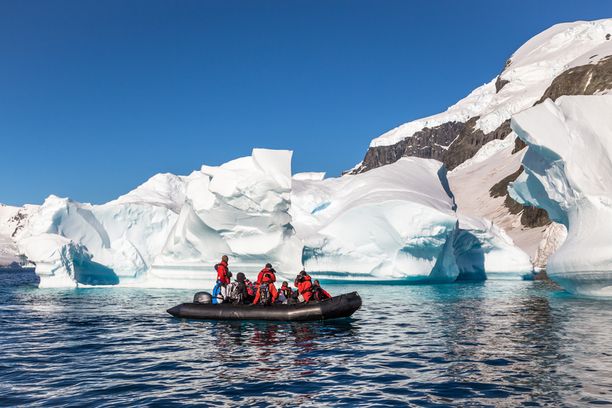
Frontiers in Science Lead Article
Published on 09 Sep 2025
Safeguarding the polar regions from dangerous geoengineering: a critical assessment of proposed concepts and future prospects
- 122,270 views
- 8 citations


Frontiers in Science Lead Article
Published on 09 Sep 2025

Experts delved into polar geoengineering at a virtual Frontiers Forum Deep Dive session on 24 September 2025.

Prof Mike Hulme (University of Cambridge, UK)—Climate engineering research risks overstating science’s capacity to deliver solutions, as the checkered history of climate control shows political, ethical, and cultural barriers can outweigh technical feasibility.

Prof Frans Berkhout (King’s College London, UK)—Polar geoengineering, originally proposed to simplify global climate governance, is instead fraught with technical, logistical, political, and economic complexities that make it highly impractical.

Prof John C. Moore (University of Lapland, Finland), and colleagues—Instead of rejecting geoengineering research, a “compassionate harm reduction” paradigm could address urgent cryosphere risks through rights-based studies integrating scientific and traditional knowledge.

Sophie Crump (Inuit Circumpolar Council, Greenland)—The rights, leadership, and knowledge of Inuit Peoples must be foundational to geoengineering and other climate policies affecting their Homelands, ensuring genuine participation and avoiding unfair burdens.

Prof Aarti Gupta (Wageningen University, the Netherlands)—A growing number of Global South governments and academics are now calling for an international non-use agreement on solar geoengineering.
Several “geoengineering” concepts proposed for the polar regions fail to meet the essential criteria required for them to be considered responsible approaches toward limiting the escalation of climate-related risks. These criteria include feasibility and likelihood of success.
Geoengineering in sensitive polar regions would cause severe environmental damage and comes with the possibility of grave unforeseen consequences.
Polar regions have complex environmental protection and governance frameworks that would probably reject polar geoengineering fieldwork and large-scale projects.
Polar geoengineering would require hundreds of billions of dollars in initial costs, plus decades of ongoing maintenance, both of which are presently unavailable and highly unlikely to be secured over necessarily short timescales to address climate change.
Geoengineering could be used by bad actors as a strategy to create the illusion of a climate solution without committing to decarbonization.
Minimizing risk and damage from climate change is best achieved by mitigating its causes through immediate, rapid, and deep decarbonization, rather than attempting interventions in fragile polar ecosystems.

A summary of the lead article in a Q&A format, with a figure and a video.

A version of the lead article written for—and peer reviewed by—kids aged 8-15 years.

Five of the most-publicized polar geoengineering ideas are highly unlikely to help the polar regions and could harm ecosystems, international relations, and reduce our chances of reaching net zero by 2050. (Photos: Prof Martin Siegert, University of Exeter, UK; Dr Heidi Sevestre, Arctic Council, Norway).

Moonshot proposals to save the planet’s ice sheets, including giant underwater sea curtains and refreezing Arctic ice, are gaining popularity as the planet heats up. But none of the most high-profile ideas are viable — worse, they may cause irreparable harm, according to a new study.

Plans to save ice in the polar regions and "repair" the climate using technology are a "flawed" distraction from the urgent need to reduce greenhouse gases, according to a new scientific assessment.

A review of the five main methods proposed for cooling down the poles or slowing the loss of ice concludes they are all wildly impractical, wouldn't work, or both.

Underwater curtains and ice thickening divert attention from cutting fossil fuel use, warns climate research group.

Plans to fight climate change by manipulating the Arctic and Antarctic environment are dangerous, unlikely to work and could distract from the need to ditch fossil fuels, dozens of polar scientists have warned.

Co-author of the lead article, Prof Steven Chown of Monash University, discusses the article's findings and argues that rapid decarbonization remains the only effective path forward.

Proposed "geoengineering" projects designed to reduce the impacts of global warming in polar regions would be ineffective, extremely costly and environmentally dangerous, researchers have warned.

A warning has been issued that 'polar geoengineering' technologies proposed to protect the Arctic and Antarctic, which are at the forefront of the climate crisis, could pose another threat rather than being a solution.

Geoengineering technologies designed to protect the climate are ineffective, expensive, and risky, scientists warn. They represent false hope: only reducing emissions can have lasting and effective results.

Researchers evaluated five geoengineering concepts proposed for Earth’s polar regions and found them to be “environmentally dangerous.”

More than 40 polar scientists are publishing a critical assessment of five methods for manipulating the Arctic and Antarctic to mitigate the impacts of global warming.

The ice in the Arctic and Antarctic is disappearing at record speed. Researchers warn against relying on technical solutions such as underwater barriers.

Proposals to artificially cool the world’s polar regions — to stem the impact of global warming — are both expensive, unfeasible and potentially dangerous, according to new scientific research.

A team of more than 40 scientists are sounding the alarm bell over risky geoengineering projects being considered at the north and south poles.

Proposals from seawater-pumping to giant underwater walls are criticised as unworkable, unsafe and a distraction from tackling the root cause of climate change.

Review finds that climate-engineering projects are ‘well-intentioned but flawed’ and risk damaging the environment.

Several concepts for polar geoengineering have been proposed, including stratospheric aerosol injection to reflect sunlight, building ‘sea curtains’ to protect ice from warming water, and deliberate thickening of sea ice. How do the proposals stack up?

Five well-publicised polar geoengineering ideas are highly unlikely to help the polar regions and could harm ecosystems, communities, international relations, and our chances of reaching net zero by 2050.

A team of international scientists is urging caution against five of the most-discussed polar geoengineering ideas, stating they are highly unlikely to help the polar regions and could harm ecosystems, international relations, and reduce our chances of reaching net zero by 2050.

Well-publicised geoengineering ideas are highly unlikely to help the polar regions and could harm ecosystems, communities, international relations, and our chances of reaching net zero by 2050.

Announcement comes after more than 40 polar scientists warned ideas to slow polar ice loss were unrealistic, unaffordable and dangerous.

An expert assessment of 5 leading geoengineering proposals considered for use in the Arctic and Antarctic has determined none are feasible or likely to succeed, and all are “environmentally dangerous”.

Scientists are beginning to take clear sides on whether or not to use human-made interventions to preserve polar ice, such as pumping up seawater or launching aerosols into the atmosphere to cool the planet’s surface.

Polar ice is rapidly vanishing in both Antarctica and the South Pole, and the world keeps circling back to the same question: Can we use technology to stop it?

Study makes the case as to why the five most considered methods are not feasible.

The worse things get for the planet, the more unworkable the suggestions to save it become. Exhibit A comprises of proposals for climate cooling interventions focused on the polar regions, which are particularly vulnerable to climate change.

Scientists have proposed using anchored seabed curtains to block warm ocean water from accelerating ice loss at Antarctica’s rapidly melting Thwaites Glacier — a possible climate fix that falls into the realm of geoengineering.

Lowering carbon emissions can delay, if not avert, catastrophic climate change, improve air quality and minimize environmental pollution. In fact, every tonne of emissions avoided today will translate to fewer shocks tomorrow, buying earth the sort of stability some are currently looking for with geoengineering.

The idea of artificially lowering the planet’s temperature is gaining supporters and hitting political opposition.
Follow the science, follow Frontiers in Science